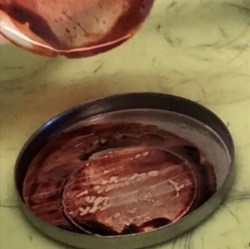When it comes to portable power, lithium-ion batteries are where it’s at. Unsurprisingly, there’s a lot of work being done to better understand how to maximize battery life and usable capacity.

While engaged in such work, [Dr. Michael Metzger] and his colleagues at Dalhousie University opened up a number of lithium-ion cells that had been subjected to a variety of temperatures and found something surprising: the electrolytic solution within was a bright red when it was expected to be clear.
It turns out that PET — commonly used as an inert polymer in cell assembly — releases a molecule that leads to self-discharge of the cells when it breaks down, and this molecule was responsible for the color change. The molecule is called a redox shuttle, because it travels back and forth between the cathode and the anode. This is how an electrochemical cell works, but the problem is this happens all the time, even when the battery isn’t connected to anything, causing self-discharge.
As [Dr. Metzger] points out, this came as a surprise in part because no one was paying much attention to “inert” components like PET. PET is present in the plastic foils and tapes that make up a battery’s internals, and while it is indeed inert at the time of cell manufacture, it can degrade within the battery and release the redox shuttle molecule. Elevated temperatures worsen this condition.
There are two papers (Identification of Redox Shuttle in Cells, and Self-discharge Originating from Redox Shuttle Generation) on the subject, and if you’d like to learn a bit more about lithium-ion batteries in general, our own Arya Voronova has you covered.
















More specifically, they were looking at LiFePO4 batteries. This is an important discovery but it becomes less relevant as we get closer to using solid state batteries which have no liquid electrolyte.
There’s yet to have been a battery tech that’s become irrelevant once well understood.
Nicads are still most common in emergency exit lights because they are dead easy to charge with minimal circuitry and fail gracefully over a decade or more when used right.
Lead acids are heavy but solved for and nothing matches them amp per dollar if you need short bursts of current and wide abuse tolerances.
Lithium batteries have huge amount of facility and industrial capacity and are well understood. Incremental improvement is dandy and can only make them more useful for what they do well.
Dismissing the last 20+ years of lithium battery tech development in favor of solid state battery tech won’t make sense until solid state cells are just flatly superior in most metrics compared to LiIon or LiFePo cells.
Lead-Acids are also ridiculously recyclable.
Which makes sense since so many UPS and automotive applications depend on them
Solid state will take another decade at least before they solve the low temperature performance issues. It’s no good to have a battery that stops working below room temperature.
I find it surprising that this wasn’t previously known. I would have expected major battery manufacturers would have discovered this in their R&D labs when doing teardown analysis of different designs after stress and usage test scenarios. Very odd.
But those rarely publish their findings so it its fully possible that (atleast part) of the industrie has known this.
Also possible they never thought to test and study exactly this way, so while they by experimentation found better combinations that may have been countering this effect they didn’t actually witness this particular effect. As they just didn’t happen to look at the right thing. Or whomever was looking didn’t realise what the colour change could mean to go into further study.
I suspect you are correct and at least part of this was part of their ‘secret sauce recipe’. But unless they actually reveal all the inhouse generated data we have no way to know, and with so many variables they will be have to be testing for it would be easy to miss something.
Companies test their products for climate and longevity all the time. In orser to get the performance envelope that you see on a spec sheet they would have had to have exposed the cell to hot / cold /humid conditions at least once.
It seems they either had the data but didn’t realize what they were looking at, or they wrote off the self discharge as the cell aging and didn’t care because that just means more sales.
Maybe due to the cell chemistry. LifePO4 is not quite the same, and uses an iron material. I actually took apart some broken phosphates a while back and noticed the same coloration wrongly attributing it to the electrolyte having been exposed to air. Its useful information however.
It’s not a bug, it’s feature. The redox shuttle and the additives that creates them are seen as cell protection in various patents and literature
Good workup here: https://www.anl.gov/partnerships/redox-shuttle-additives
I have cut open a defunct LiPo battery (won’t take a charge and bulges when charged) with my scissors to find that the electrolyte was red. This is very interesting.